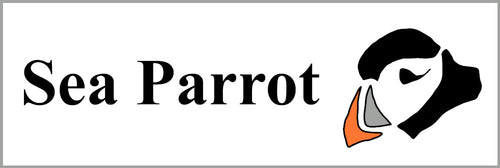(This tutorial has been updated)
I make Christmas bunting nearly every year to give to friends and family as an early Christmas present, and it helps to get me in the Christmas spirit too. It's quite an easy but very pleasing make. Here, I've added some of my robin fabrics to give it that little bit extra.
To make 12 flags you will need:
You can make the bunting from fat quarters or scraps (see quantities below). You will also need approximately 2.5m of bias binding 1 inch wide (when sides folded in) and 12 robins from Sea parrot:
https://www.seaparrot.co.uk/products/robin-fabric-strip
To make bunting from FAT QUARTERS:
You will need 2 fat quarters, if your bunting is double sided, and 1, if you are using plain fabric for the backs. The pattern must have no orientation. I used my Sea parrot Holly fabric:
https://www.seaparrot.co.uk/products/holly-fabric-fat-quarter
To cut 12 triangles from 1 fat quarter, cut 2 strips, each 18 cm wide, widthways across the fat quarter (see photo below).
On each strip, on the back, starting at 0 cm, make a small mark every 16 cm (at 16, 32 and 48 cm) across the top of the strip. Then make a small mark, starting at 8cm, every 16 cm (8, 24,40 and 56 cm) along the bottom of the strip. Join these marks up, as below, to make triangles and cut out. 

To make bunting from SCRAPS:
You will need 12 or 24 Christmas fabric pieces at least 18 cm square and use a template to cut out the the triangles. The key thing to remember is to cut the triangles out in the right orientation. You don't want upside down reindeer!
To make the paper template, take a piece of scrap A4 paper and fold it in half width-ways. Make a firm crease. Mark a point 8cm away from the fold along the top edge and 18 cm from the top along the fold as in the picture below (it should say 8 cm along the top, not 18 cm!). Join the marks and cut along the diagonal to give you your triangle template.

Pin the template to you patterned fabric, in the correct orientation, and cut out. I used a plain white fabric for the back as I plan to hang it against the wall but if you are hanging your bunting across the room, cut out two patterned triangles. Repeat for the number of triangles you want on your bunting.


For BOTH fat quarters and scraps:
Take the robin fabric and cut out the motifs in rectangles leaving approximately 1/4 inch between the robin and the edge of the rectangles.


Pin a robin to the front of one of the patterned triangles, 3/4 inch from the top of the triangle. Using a zig zag stitch (I used width 2.5 and length 1.0) sew approximately 1/8 inch from the rectangle edge, the robin rectangle to the front triangle. When you get to a corner, stop to turn with the needle on the right hand side, otherwise you will leave a gap in the corner. Fasten off using reverse stitch. I used white cotton but if you are a neat sewer, you may want to use a more noticeable thread such as red or black. Repeat for all your front triangles.

Place a front and a back triangle together with right sides facing. Pin along one diagonal side with the pin points facing the point of the triangle, turn over and pin along the other diagonal side in the same way. Sew starting at the point of the triangle all the way along a diagonal side with a 1/4 inch seam and taking out the pins as you go. Fasten off. Turn the triangle over and do the same on the other side making sure the seam is very secure at the point of the triangle by maybe reverse stitching there.

To remove bulk, cut the tip of the triangle off and trim the side seams near the triangle point.

Turn the triangle the right way out and use something blunt to push out the point. I use a chopstick. Carefully iron the triangle flat with a clean cotton cloth between the iron and bunting.

Next, fray the edges of my robin rectangle using a pin to tease out the strands which you can then remove. This is part of the process is optional.

Repeat the process for all your bunting triangles.
Now it's time to sew the bunting to your bias binding. Trim off the excess fabric at the top of the triangles to give a straight edge. Work out how far you want your triangles to be apart and how much bias binding you will then need, remembering to leave excess at the ends for tying. I made 12 triangles, placed them 1 3/4 inches apart and used 94 inches (238 cm) of bias binding.
Fold the bias binding in half and mark half way. If you have an even number of triangles, starting in the middle and working out towards one end, pin the top of half of your triangles to the bias binding with the desired distance between them. Remember that the space from the middle of the bias binding to the first triangle is half the distance. The bias binding should be folded in half lengthways and pinned with one half behind and then other half folded over the front of the top of the triangles. Repeat with the other half of the triangles pinning from the centre and out towards the other end. If you have an odd number of triangles, pin one triangle in the middle and work outwards.

Sew all the way along the bias binding as close to the lower edge as possible. Your bunting is finished!

